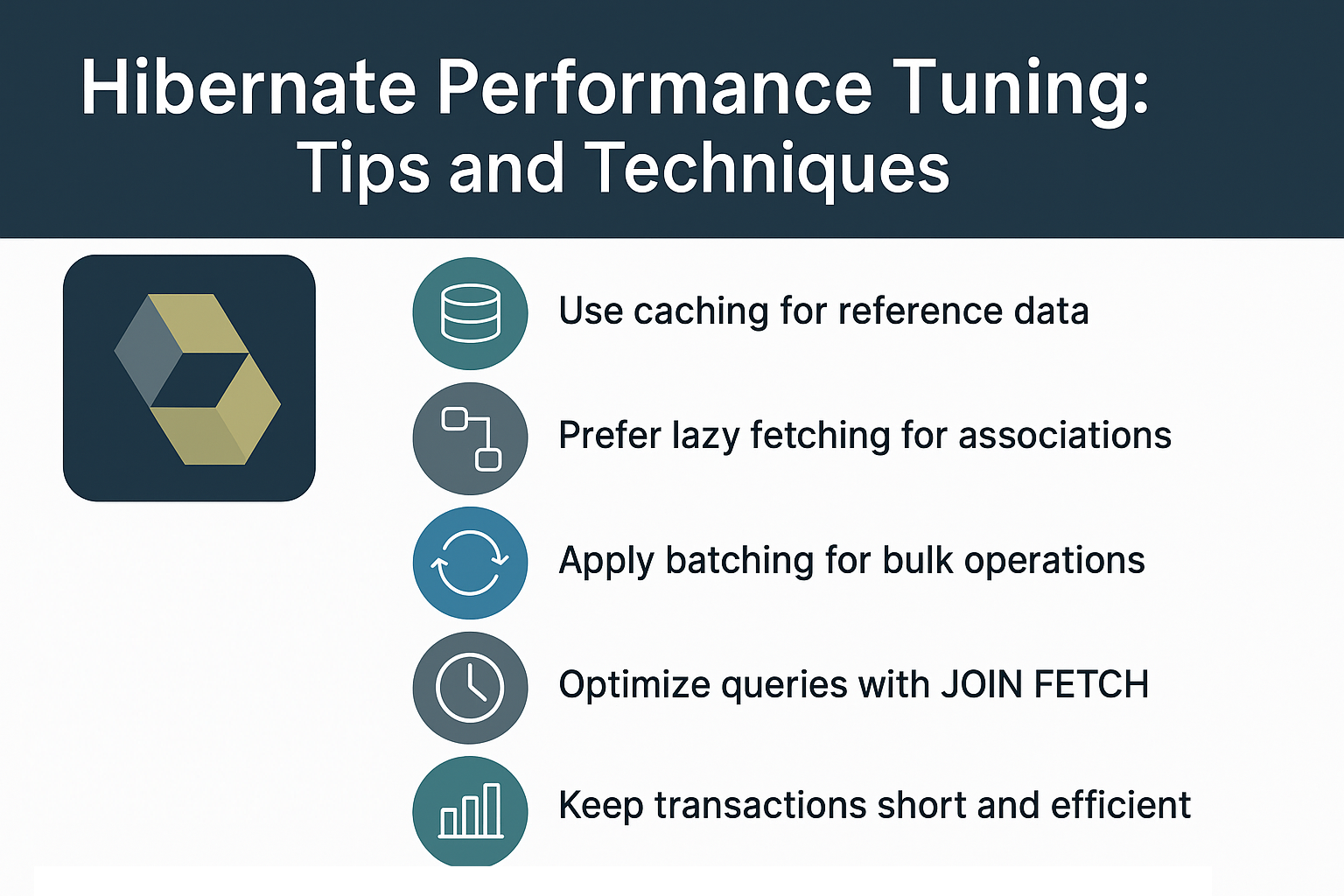Hibernate simplifies persistence with powerful ORM features, but if used incorrectly, it can introduce performance bottlenecks such as slow queries, memory overuse, and excessive database calls.
This tutorial explores performance tuning tips and techniques for Hibernate, from caching and fetching strategies to query optimization and batch processing. By applying these strategies, you can ensure that your Hibernate-powered applications are scalable, efficient, and production-ready.
Common Performance Challenges in Hibernate
- N+1 Select Problem – fetching related entities with multiple queries.
- Unoptimized Fetching – using
EAGERfetch unnecessarily. - Excessive Session Size – too many objects in persistence context.
- Poor Caching Strategy – not leveraging second-level cache.
- Bulk Operations – inefficient inserts/updates.
Analogy: Imagine ordering 100 items from a restaurant. Instead of asking for all at once, you ask for one at a time (N+1 problem). Hibernate can optimize this with batching.
Optimizing Entity Mapping
Example Entity
@Entity
@Table(name = "employees")
public class Employee {
@Id
@GeneratedValue(strategy = GenerationType.IDENTITY)
private Long id;
private String name;
@ManyToOne(fetch = FetchType.LAZY)
@JoinColumn(name = "department_id")
private Department department;
}
✅ Best Practice: Always use lazy loading for relationships unless eager fetching is required.
Hibernate Fetching Strategies
- Lazy Fetching (default): Loads associations only when accessed.
- Eager Fetching: Loads associations immediately.
Example: JOIN FETCH to Avoid N+1
String hql = "SELECT e FROM Employee e JOIN FETCH e.department";
List<Employee> employees = session.createQuery(hql, Employee.class).list();
✅ Best Practice: Use JOIN FETCH to load associations when needed in a single query.
Batch Processing
Hibernate allows batch fetching and batch inserts/updates to reduce query count.
Configuration
spring.jpa.properties.hibernate.jdbc.batch_size=50
spring.jpa.properties.hibernate.order_inserts=true
spring.jpa.properties.hibernate.order_updates=true
Example Batch Insert
for (int i = 0; i < 1000; i++) {
Employee emp = new Employee();
emp.setName("Employee " + i);
session.save(emp);
if (i % 50 == 0) {
session.flush();
session.clear();
}
}
✅ Best Practice: Use batching for bulk operations to minimize round trips.
Caching Strategies
First-Level Cache
- Per-session, enabled by default.
Second-Level Cache
- Shared across sessions.
- Example: Ehcache, Infinispan, Redis.
@Cacheable
@Entity
public class Department {
@Id
private Long id;
private String name;
}
Query Cache
- Stores query results, requires second-level cache enabled.
- Best for read-mostly queries.
✅ Best Practice: Cache reference data, not frequently updated transactional data.
Query Optimization
Use Parameterized Queries
Query query = session.createQuery("FROM Employee WHERE name = :name");
query.setParameter("name", "Alice");
Criteria API Example
CriteriaBuilder cb = session.getCriteriaBuilder();
CriteriaQuery<Employee> cq = cb.createQuery(Employee.class);
Root<Employee> root = cq.from(Employee.class);
cq.select(root).where(cb.equal(root.get("department"), "Engineering"));
List<Employee> result = session.createQuery(cq).getResultList();
✅ Best Practice: Avoid string concatenation in queries to prevent SQL injection and improve caching.
Transaction Management
Always use transactions for CRUD operations.
Session session = sessionFactory.openSession();
Transaction tx = session.beginTransaction();
Employee emp = new Employee();
emp.setName("Alice");
session.save(emp);
tx.commit();
session.close();
✅ Best Practice: Keep transactions short and efficient to avoid locking issues.
Real-World Integration with Spring Boot
@Repository
public interface EmployeeRepository extends JpaRepository<Employee, Long> {
List<Employee> findByDepartment(String department);
}
Spring Boot integrates Hibernate with Spring Data JPA for simplified repository management.
Anti-Patterns and Pitfalls
- Using
EAGERfetching everywhere. - Keeping long-lived Hibernate sessions.
- Overusing query cache → stale data issues.
- Using
updateorcreate-dropin production. - Ignoring SQL logs → unoptimized queries.
Best Practices Checklist
- ✅ Use lazy fetching by default.
- ✅ Apply batching for bulk inserts/updates.
- ✅ Cache read-only/reference data.
- ✅ Optimize queries with
JOIN FETCH. - ✅ Use DTO projections for reporting queries.
- ✅ Monitor Hibernate metrics and SQL logs.
- ✅ Integrate schema migration tools (Flyway, Liquibase).
📌 Hibernate Version Notes
Hibernate 5.x
- Uses
javax.persistence. - Legacy SessionFactory setups still common.
- More reliance on XML + annotations.
Hibernate 6.x
- Migrated to Jakarta Persistence (
jakarta.persistence). - Enhanced SQL query engine.
- Better support for batching and fetch optimizations.
Conclusion and Key Takeaways
Hibernate provides powerful ORM capabilities, but performance issues can arise if not tuned properly. With the right fetching, caching, batching, and transaction strategies, Hibernate applications can achieve high performance at scale.
Key Takeaway: Monitor queries, choose caching wisely, and always optimize fetching and batching for production-grade applications.
FAQ: Expert-Level Questions
1. What’s the difference between Hibernate and JPA?
Hibernate is an implementation of JPA with additional features.
2. How does Hibernate caching improve performance?
By storing frequently accessed entities in memory to reduce database hits.
3. What are the drawbacks of eager fetching?
It loads unnecessary associations, slowing queries.
4. How do I solve the N+1 select problem in Hibernate?
Use JOIN FETCH, batch fetching, or entity graphs.
5. Can I use Hibernate without Spring?
Yes, Hibernate works standalone, but Spring Boot simplifies integration.
6. What’s the best strategy for inheritance mapping?SINGLE_TABLE for performance, JOINED for normalization, TABLE_PER_CLASS for flexibility.
7. How does Hibernate handle composite keys?
Via @EmbeddedId or @IdClass annotations.
8. How is Hibernate 6 different from Hibernate 5?
Hibernate 6 introduces Jakarta Persistence and better SQL optimization.
9. Is Hibernate suitable for microservices?
Yes, if each service owns its database and schema.
10. When should I not use Hibernate?
Avoid Hibernate when raw SQL performance or NoSQL flexibility is needed.
